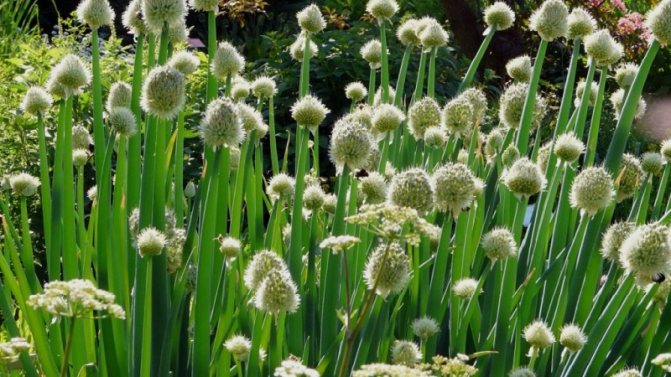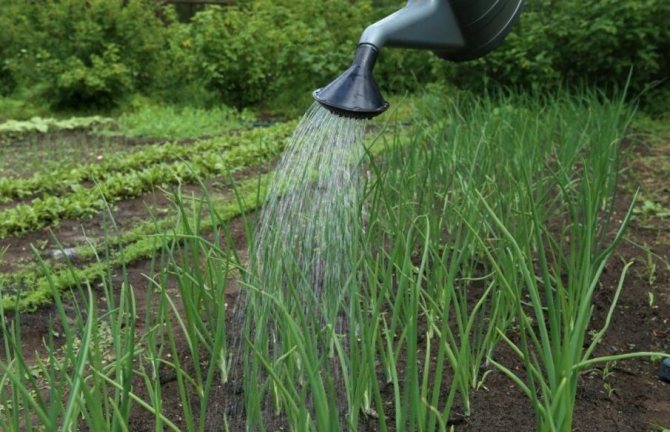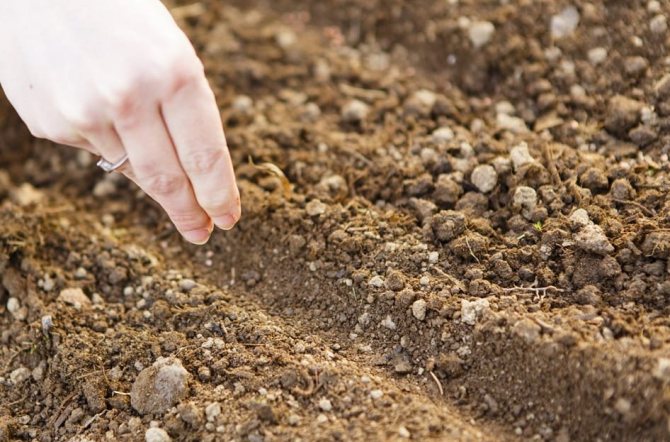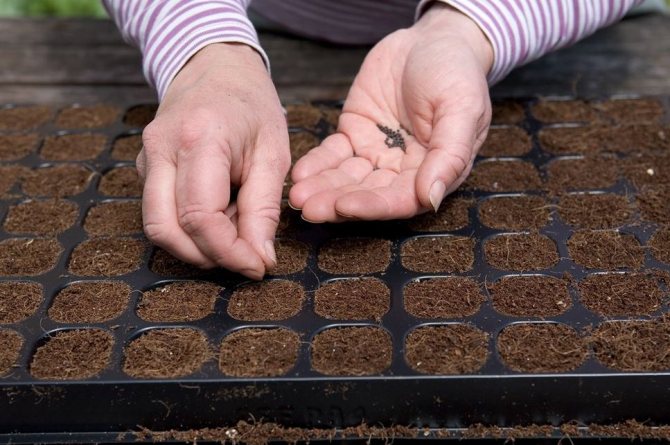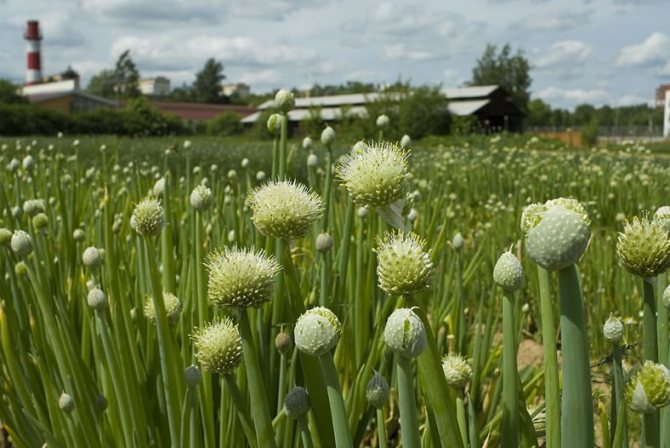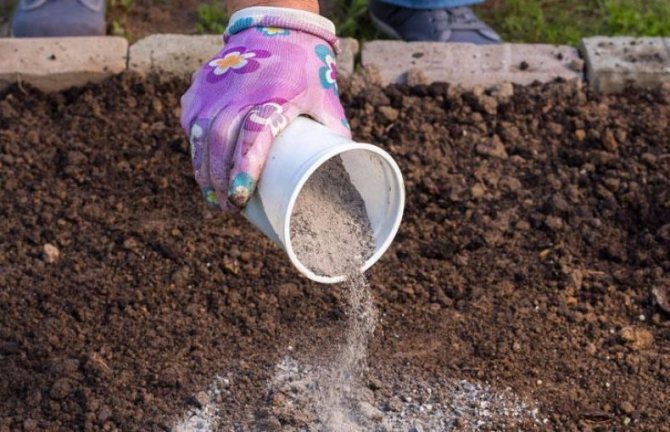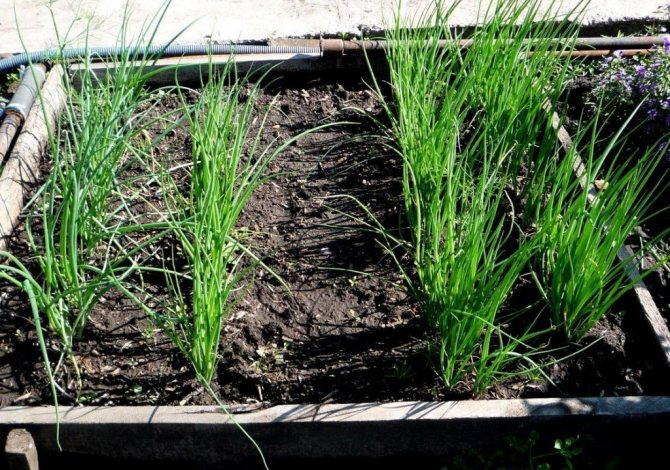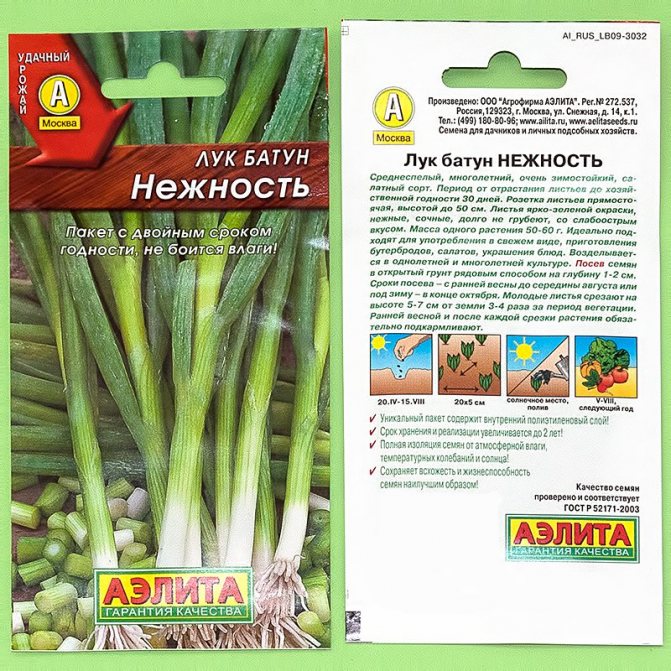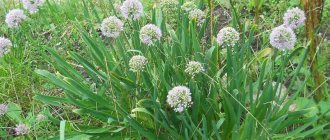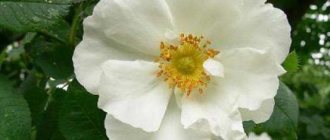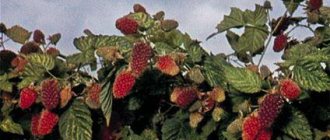Everyone knows about the usefulness of onions. But ordinary varieties of onions are used only in cooking, and the Batun variety is also used in medicine. Due to the content of essential oils in it, it has an unusual smell and taste, not quite typical for onions. The green feathers of this plant variety contain a lot of ascorbic and niacin. And in medicine it is appreciated for the fact that with the help of it they make medicines to improve the condition of the capillaries. Which helps to reduce high blood pressure. Therefore, the benefits of this plant are undeniable. And everyone needs to grow it, even a non-professional gardener.
Why exactly a bunch of onions?
I chose the onion based on the following characteristics of this variety, the list of which is given below:
- The plant boasts high frost resistance, which surpasses other varieties of onions familiar to us. Even young "feathers" are resistant to temperatures down to -8 ° C, and the onion itself tolerates winter frosts down to -30 ° C;
- The plant is extremely resistant to high soil moisture, which is important for regions with cold and wet springs, as well as rainy summers. In addition, the batun grows well in places with a close location of groundwater;
- The plant is famous for its mild taste, as well as the delicate structure of the green "feathers" themselves, despite their large size. It is the size of the "feathers" of this bow that repels most beginners, since the feathers themselves look overripe, which in practice is completely different;
- The spring onion has been consistently producing a harvest of about 7 years, which is a record among other onion varieties;
- The plant is suitable as an annual, as it brings a bountiful harvest the next season;
- The plant has succulent shoots, the size of which is 2 times larger than ordinary onions;
- The bunch of onions has many varieties, and every gardener will find exactly what he needs.
Site selection
It is quite easy to grow a batun. It is undemanding to external conditions as much as the onion "relative". Onions can be planted in the lowlands, in the shade of trees. In this case, attention should be paid to the acidity of the soil. A high level of this indicator will not allow the onion to develop safely. Therefore, before sowing batun seeds, it is recommended to reduce the acidity level to a neutral indicator by adding dolomite flour, wood ash (0.5 l / m2), lime to the soil. A decrease in acidity occurs in six months, therefore, these substances need to be introduced in advance in the summer.
Important! The best substrate for onions is sandy loam and loam.
The moisture level for the baton is very important: a juicy green feather will form only at a high level of moisture, but moisture stagnant in the soil can harm the onion and provoke its premature shooting.
Crops that have previously grown on the selected plot of land will in a certain way affect the growth of onions: legumes, green manures, tomatoes and cabbage have a beneficial effect on the batun. It is not recommended to grow a batun in the place of onions, garlic or carrots.
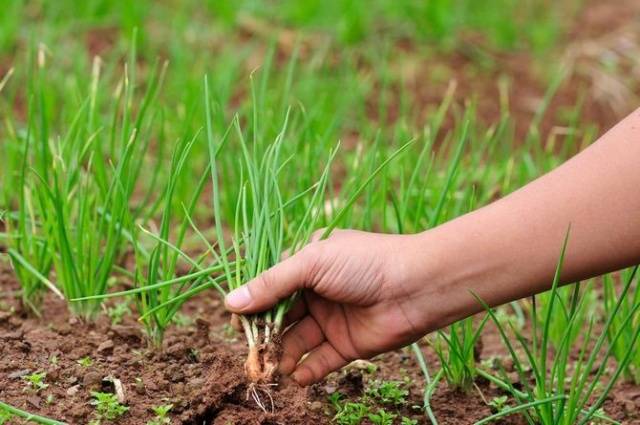
Important! The optimal place for the trampoline is a slope in the shade of trees with sandy loam soil.
Basic description and features
Batun onions have several obvious differences from the standard varieties of onions, the main of which I have indicated below:
- The onion does not have a bulb like onions, and is only suitable for consumption in a green form. The cultivar has a false bulb that is unfit for human consumption;
- The onion boasts "feathers" up to 40 cm high and up to 3 cm in diameter. Most often, the diameter of the "feathers" is 2 cm;
- The onion contains 2 times more vitamin C than its onion counterpart;
- The onion has a developed root system, the length of which can reach 35-40 cm;
- Batun onions reproduce not only by seeds, but also by dividing the bush.


Suitable varieties
Late-ripening varieties are best suited for planting a batun before winter.... They produce greens in 150-180 days and are highly productive. From 1 sq. m it is possible to collect 2-3 kg of green feathers.
The best late-ripening varieties:
- May... Winter hardy (withstands up to -45 ° С), strongly branched. The leaves are dark green with an abundant waxy bloom. The feather grows late in the spring. From the moment of germination to full ripeness, 45-50 days pass. The plant throws out arrows up to half a meter high. In the second year, it forms up to five stems. The taste is spicy, tangy, sweet.
- Gribovsky... High-yielding, perennial, branched plant. Green feathers sprout slowly. The onion head is almost invisible from the ground. From the moment of sowing until the first greens appear, 60-65 days pass. Leaves are erect, 40 cm long, fall without support. The taste is mildly pungent with a slight bitterness and a persistent onion smell.
- Seryozha... The growing season is 80-110 days. The taste is semi-sharp. Green feathers are delicate, thin, sweet, up to 1.5 m high. The plant forms a white bulb.
- Ishikura long white. The growing season is 100-110 days after germination. Stems are erect, up to 55 cm high, dark green in color with a strong waxy bloom. False stem without anthocyanin coloration. The taste is pleasant, semi-sharp.
- Early meal... The growing season is 100-110 days after germination. Stems are erect, 40-45 cm high, dark green with a slight waxy bloom. The taste is sweetish, slightly pungent.
In Russia, the onion is often called the "Tatar"since it was introduced by the Mongol-Tatars.
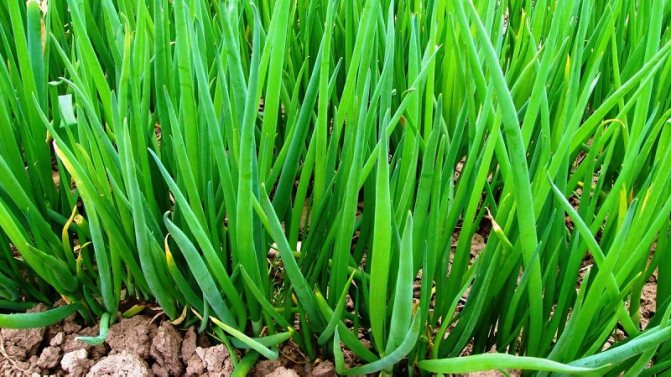

Growing and care
If you want to grow onion on your site, but you have no experience with this culture, just follow the following points:
- If you need a bunch of onions as an annual plant, start sowing seeds in early spring as soon as the snow melts. If you want the onion as a perennial plant, sow the seeds from June to mid-July. After planting seeds in any of the indicated time ranges, the harvest should be expected in the next season;
- Find out what kind of soil prevails on your site. If the soil is heavy, onion seeds are sown in beds up to 1 meter wide, in lines with a distance of about 20 cm from each other (we recommend making 5 lines per garden bed). If the soil is light, sow seeds in the beds, making 5 lines at a distance of 25-30 cm. The next 5 lines are made at a distance of 50-60 cm from the previous sown area;
- Prepare the soil for planting. A few weeks before planting the seeds, the soil should be fertilized with compost, wood ash, or overripe manure. The concentration of fertilizers does not play a special role, it is enough just to dig up the area to a depth of 15 cm, and add one of the fertilizers listed above. The layer of applied fertilizers should not exceed 3 cm. The place for planting onions should be in partial shade, since direct sunlight makes the “feathers” yellow and ages quickly;
- Having chosen the place and time of planting, proceed with the preparation of the seeds. The preparation takes place by soaking the seeds for 1 day in warm water (you need to change it at least 3 times a day), or soaking the seeds in a growth activator, for about 3 hours (in accordance with the instructions on the activator package). Prepared seeds are planted to a depth of 1.5-2 cm. Seeds may not be prepared, but in this case the seedlings will appear later, especially if the spring is cold.When planting in spring, the seeds do not need watering before germination, if planting seeds in summer, watering is required, since the harvest will be only for the next season, but the bulb itself, the root system, and the first shoots will begin to form already this season. A place with planted seeds should be watered abundantly at least 10-15 times throughout the summer, do not allow the soil to dry out, and remove all weeds;
- If you sowed onions in June, you can harvest the first crop in May. If you sowed onions closer to autumn, the first harvest awaits you in July. After the first harvest, the next one will be in 1.5-2 months. If it was found that the sowing of the seeds was too dense, and the seedlings began to intertwine with each other, they should be thinned out every 5-8 cm from each other. If seedlings are not thinned out, they will be numerous and small. The more the area is overgrown, the smaller and thinner the onion crop will be.
It is important to note a few more points when planting the seeds of this onion. So, immediately after planting the seeds, the soil around them is mulched with humus, by laying it out on the surface of the earth with a layer of 1.5 cm, after which the soil is not loosened, but slightly compacted. Every spring, onion beds are abundantly supplied with mineral fertilizers.
Important: If you plant the onion in clay or sandy soil, its "feathers" will be rough and unpleasantly bitter in taste. Onions are capable of accumulating nitrates from the soil, which means that you should not get carried away with pesticide treatment. Mustard powder is used to repel pests. Mustard powder does not affect the taste of onions, and is also completely safe for humans.
When to sow
Timing of planting a batun determined taking into account the weather conditions of each region or according to the lunar calendar.
Auspicious days according to the lunar calendar
Sowing seeds is performed in October - November. before the onset of stable frosts.
Sowing dates for 2019:
- October: 1-5, 8-11, 15-17, 21, 29-31;
- November: 1-3, 5-8, 11-13, 17, 20, 27-30.
Sowing dates for 2020:
- October: 1, 4, 6, 8, 10, 14, 17-23, 26,27, 31;
- November: 2, 4-6, 12, 16-19, 22, 24-30.
Suitable weather conditions for sowing
The tramp is sown up to three times per season.: in April, June, October and November. Sowing work is carried out before the onset of stable frosts. The optimum daytime temperature is + 4 ... + 5 ° С.
Increased yield
Having figured out how to grow a batun onion, you can talk about measures to increase its yield. So, in early March, when the snow has not yet melted, the place where the batun is sown is covered with a thin layer of peat, straight onto the snow. When the snow begins to melt, the peat will create a kind of film on the ground, and in such conditions the onion will not only taste more delicate, but will also bring the first harvest 2, and under good conditions, 3 weeks ahead of schedule.
After each harvest, the cut sites should be fed with a slurry solution (1: 6), to which 30 g of ammonium nitrate, 20 g of superphosphate, and also 20 g of potassium chloride are added. The last harvest should be carried out no later than the first decade of September, so that the onions have time to recover and prepare for winter.
If you wish, at the beginning of winter, you can sow onion seeds at home. The seeds will sprout by the beginning of spring, when the soil temperature stabilizes at + 10-15 °, they can be transplanted to the garden bed. This method will accelerate seed germination by at least 1 month.
An early harvest is also facilitated by covering the onion growing area with plastic wrap, which is placed in the first half of April and harvested after the first harvest. This method will speed up the maturation of the "feathers" by several weeks.
Culture transplant
The need to transplant onions can arise for various reasons, for example, in order to free up a site for planting another crop or for other needs.The operation is carried out in early spring, although some gardeners perform it in August or early September. For transplanting, you need to choose a suitable site, prepare the holes, carefully dig out the best plants and transfer them to a new place. Planting culture should be performed at the same level, i.e. without deepening and elevation. When the procedure is completed, it is necessary to moisten the soil.
Little Tricks Everyone Should Know About
Planting and subsequent care of the presented variety of onions is a fairly simple activity available to every beginner. Despite this, experienced gardeners advise not to neglect the recommendations of the following types:
- Batun onions grow best in beds where tomatoes, potatoes and carrots previously grew;
- It is undesirable to plant onions in beds where other varieties of onions previously grew, since the soil after them may contain various fungal and bacterial pathogens, and, in general, have an unfavorable chemical composition throughout the year;
- Despite the fact that the onion is resistant to moisture, regular overflows can lead to oxygen starvation, and in some cases to death. Water the onions abundantly, but do not turn the garden into a swamp;
- The onions are watered abundantly 3 days before harvest. Watering will allow the feathers to acquire the most attractive presentation;
- As a planting material for greenhouses, mainly 2-3 year old plants are used, which are dug up in the middle of autumn with a root system and a false bulb.
Crop rotation rules
Onion planted after white cabbage and cauliflower, broccoli, tomatoes, peas, beans, zucchini, eggplant, flax, lupine, oats. Bad predecessors are garlic, carrots and onions.
Batun refers to perennial crops and is capable of producing greens for 7-10 years... However, the quality of the crop decreases. The peak of fertility falls on 3-4 years from the moment of the first sowing. A year later, a decrease in yield is observed. Therefore, 4-5 years after planting the trampoline, a new bed is created and the seeds are sown again.
Thus, it is possible to replace low-yielding plantings with new ones. Seeds are harvested from the old garden bed, dried, processed and sown. Such a crop rotation does not require cash investments.
Output
The onion onion will become, without exaggeration, one of the best onion varieties that can be grown in the open field of our latitudes. Caring for this variety is extremely easy, making it the best choice for a beginner.
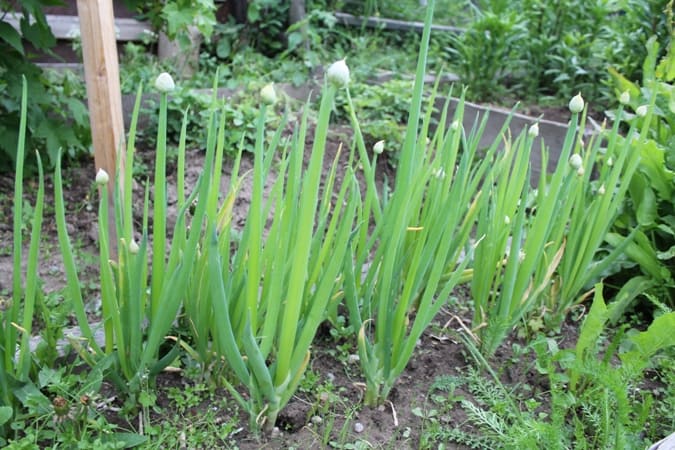

As for the variety of varieties of this onion, when choosing seeds, carefully look at the photo located on the package, and also carefully read about each specific variety. The fact is that all varieties have their own characteristics, for example, increased resistance to pests, cold weather, drought, early maturity, etc. For detailed information on each individual variety, read specialized sources of a professional level!
How to sow correctly
After fertilization, the bed is leveled and furrows are formed at a distance of 15-20 cm.
The sowing depth depends on the soil:
- into light, sandy loam and loamy seeds, they are buried by 3 cm;
- into heavy, hammered - to a depth of 2 cm.
Sowing the reel too deep makes it difficult to germination of greenery in spring.
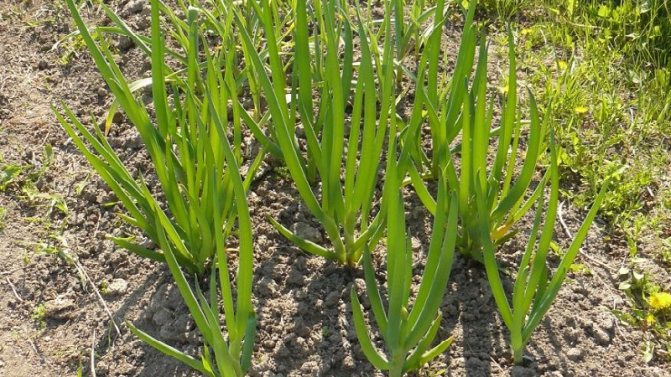

The culture is highly frost-resistant, therefore even severe frosts do not threaten her, provided that the sowing dates are observed... However, experienced gardeners advise covering the beds with mulch - peat, hay, straw, dry branches or foliage, sawdust. This coating prevents deep soil freezing.
With the arrival of the first ground frosts, the site is additionally covered black agrofibre. Non-woven fabric actively absorbs ultraviolet light and promotes rapid soil thawing in spring.
Harvest
For harvesting the first crop of vegetables, plantings of the second year of life are taken. Although it is possible to cut the leaves after a month has passed from the day of sowing. The green mass is completely removed in the fall before winter, but no later than a month before the onset of frost.
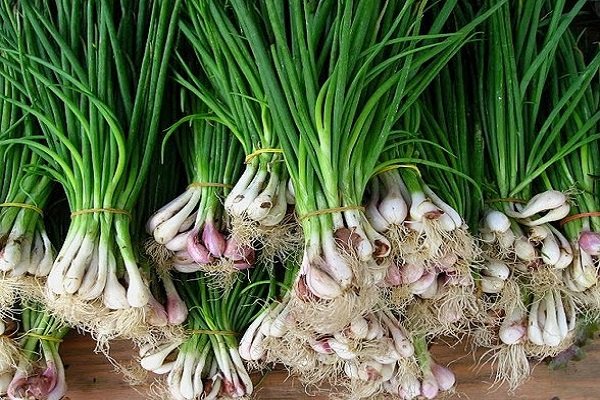

Cut the next year when the onion appears in spring and reaches a height of 20 centimeters.
Cut the stems closer to the surface of the earth. The leaves are sorted out, tied in bunches and wrapped in film. Store the leaves in the refrigerator. The dug out onion can also be placed on the bottom of the refrigerator without removing the leaves. The green color of the stem is decorated with salads, sprinkled with dishes.
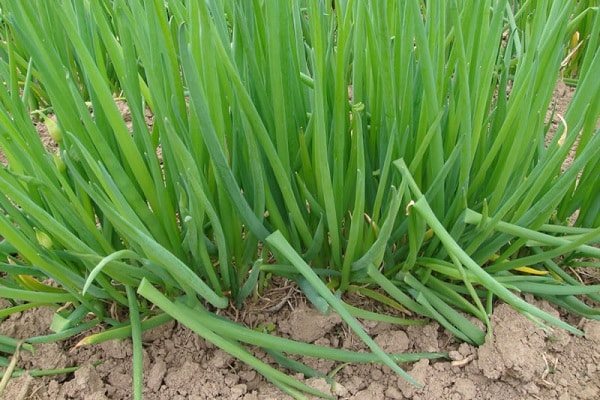

Soil requirements
The onion loves sod soil, rich in humus, but not acidic. A good place for him would be loam or sandy loam soil. You can plant it in a place that does not meet these requirements, but to get a harvest, the soil will have to be enriched. Peat, black soil are added to the sand, and rotted organic matter is added to the loam. Acidic soil needs to be limed.
The place for planting must be chosen so that the sun illuminates the plant not all day. You can even sow it in the shade. It is recommended to plant the onion after legumes, cabbage, pumpkin, zucchini. If tomatoes were previously grown in this place, the risk of infection of the plant with a fungus increases. It is also undesirable to plant it after garlic, onions, cucumbers, carrots.
It is advisable to prepare a place for landing in advance. When sowing in spring, this should be done in the fall. After applying mineral fertilizers and organic matter, the soil must be dug up and beds formed. It is recommended to fertilize the soil with rotted manure in the amount of 100 g / sq. The following fertilizers are also useful: nitrogen - 10 g, phosphorus - 12 g, potassium - 8 g.
When sowing seeds in open ground, it is very important to thoroughly free the soil of all weeds. The onion is very sensitive to such a neighborhood, and it is difficult to weed. Young shoots are so thin, and the roots are tender, that the plant itself is pulled out along with the weed.
General information
The plant is divided into 3 subspecies, slightly different from each other: Chinese, Japanese and Russian. It is the latter that is most common in our country, as it is adapted to its climatic conditions. Outwardly, the plant is similar to onions, but its feathers are wider and longer, inside they are hollow.
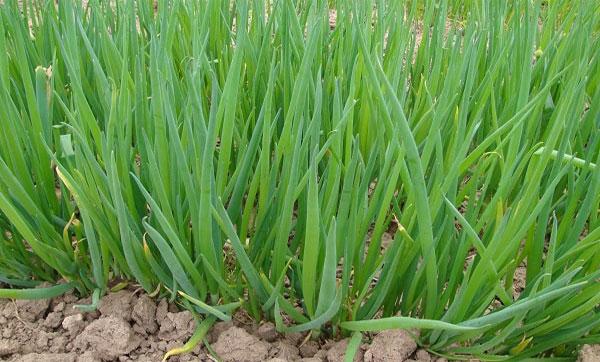

The aboveground part of the batun is of food interest. The oval bulb, which is an underground part of the culture, consists of bunches of false stems that are thickened. The lack of a dense skin makes it impossible to preserve it for a long time.
Onions are highly frost-resistant. It can grow up to 11 years old and does not freeze out even in a snowy winter. To maintain the ideal state of the bush, replanting it to a new place is recommended once every 4 years.
Globular white inflorescences on tall peduncles appear 2 years after planting. The maximum productivity of onions occurs in the first 4 years. Its fall in the future occurs due to the thickening of the plantings, since a large number of daughter bulbs are formed.
The plant contains most of the vitamins and minerals necessary for human health. Among all types of onions, batun is the leader in the amount of vitamin C it contains. 100 g of its greens contain the daily norm of vitamin C.
Seed preparation
Be sure to carry out pre-sowing processing of seed material:
- Soak for 15-20 minutes in a weak solution of potassium permanganate. Then rinsed well in clean water;
- For 10-12 hours, they are soaked in a growth stimulator, which significantly accelerates germination.
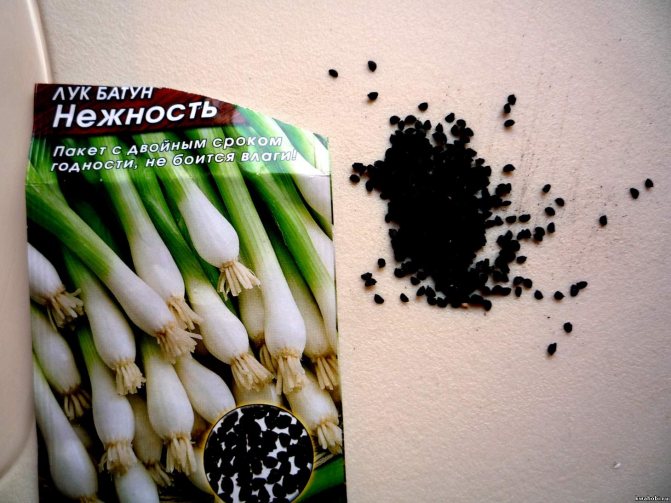

Onion seeds
Watering
The plant is classified as a moisture-loving crop, so it requires frequent but moderate watering. The soil should be saturated with water to a depth of 20 cm.
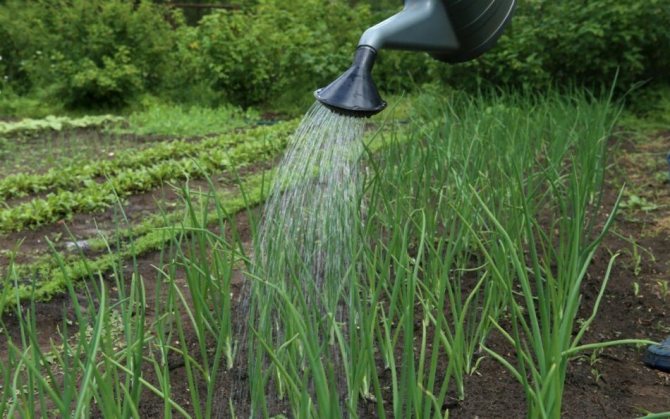

Irrigation with water
When it rains a lot, you can reduce the amount of watering or even cancel it altogether.In dry weather, watering is carried out about 2 times a week, and in extreme heat - 3 or 4 times a week. Water is needed not cold, but at room temperature. It is preferable to use settled water, rain can be used.
How to care for plantings
After completing the sowing work and covering the beds, you can breathe out and rest. With the arrival of spring, when the snow melts, the agrofibre and mulch are removed. The first shoots appear in 5-6 days. The grown onions are immediately thinned out, since thickened plantings will cause low yields.
In the spring, the batun slowly grows a green feather... To stimulate the defenses and enhance the growth of plantings, watered with "Epin" or "Zircon".
Further care includes:
- Moisture control, planting watering as needed, taking into account the high moisture demand of young plants. The soil is poured to a depth of about 20 cm. In a drought, the batun is watered every other day. In moderate weather, watering is carried out with warm water twice a week under the root.
- Regular loosening of the beds after rain and watering and weeding as the weeds grow.
- In the first year after sowing the trampoline before winter, fertilizers do not need to be applied. It is permissible to dust the beds with wood ash to increase plant productivity and protect against insects. In the future, plantings are fertilized with mullein (1:10) or chicken droppings (1:15).
Protection against diseases and pests
Batun onions are susceptible to downy mildew (downy mildew)... The leaf plate is covered with a gray-purple moldy bloom. The growth of the plant stops.
Rust on green feathers appears as yellow, rounded spots... The presentation of greens is significantly deteriorating, the leaves die off and the yield decreases.
For prevention and treatment diseases use drugs with copper: "HOM", "Oxyhom", copper sulfate, 1% solution of Bordeaux liquid. 2-3 treatments are enough.
The onion is often attacked by the onion leaf beetle-cracker... Adults hibernate in the soil, and in early spring they rise to the surface and begin to actively feed on young greenery. An adult beetle 6-7 mm long has an oblong shape. The color is orange-red, antennae and eyes are black, limbs are red. The larva is thick, convex, dirty yellow in color.
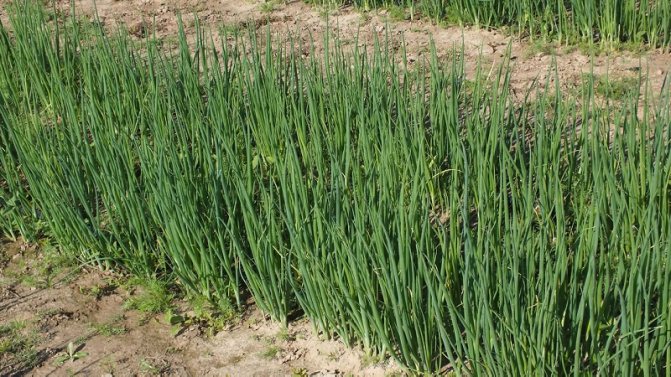

Adult onion weevils pierce a feather and suck out the juice. Weevil larvae bite into greenery and feed on plant tissue.
Onion fly larvae eat the bulbs, which leads to wilting and yellowing of the plant.
Onion Lurker hibernates under plant debris, lumps of soil. It comes to the surface after the snow melts. It feeds on the young green feathers of the trampoline. Larvae and beetles cause harm. Damage looks like needle pricks, closely spaced along the sheet.
It is not recommended to use strong chemical preparations for onion processing.... Green mass actively accumulates toxic substances, therefore, its use leads to poisoning of the body.
Diseases and insect attacks are easier to prevent using such methods:
- Sowing onions in the same area no earlier than 4 years later.
- Cultivation of crops on fertile soil.
- Compliance with the regime of watering, loosening the beds.
- Timely Weed Harvesting - Most insects lay their eggs in the weeds.
- Removing sick, dead and damaged plants from the site - they spread infectious diseases.
- Use for sowing healthy planting material from the manufacturer and preventive treatment of seeds harvested by hand with a solution of potassium permanganate.
- The use of deterrent agents: potatoes treated with creolin or creosote, mulching the beds with peat, dusting with tobacco tobacco and ash.
- Watering at the root with a decoction of tobacco. Insist 1 kg of fresh or 500 g of dry raw materials in 10 liters of boiling water for 12 hours, dilute with clean water 20-30 times, add 30 g of shavings of laundry soap.

